
Rechargeable hearing aids

Invisible hearing aids

Bluetooth hearing aids

Completely-in-Canal (CIC)

Behind-the-Ear (BTE)

Receiver-in-Canal (RIC)
Rechargeable
hearing aids
Just charge overnight to provide
convenient, long-lasting amplified hearing.
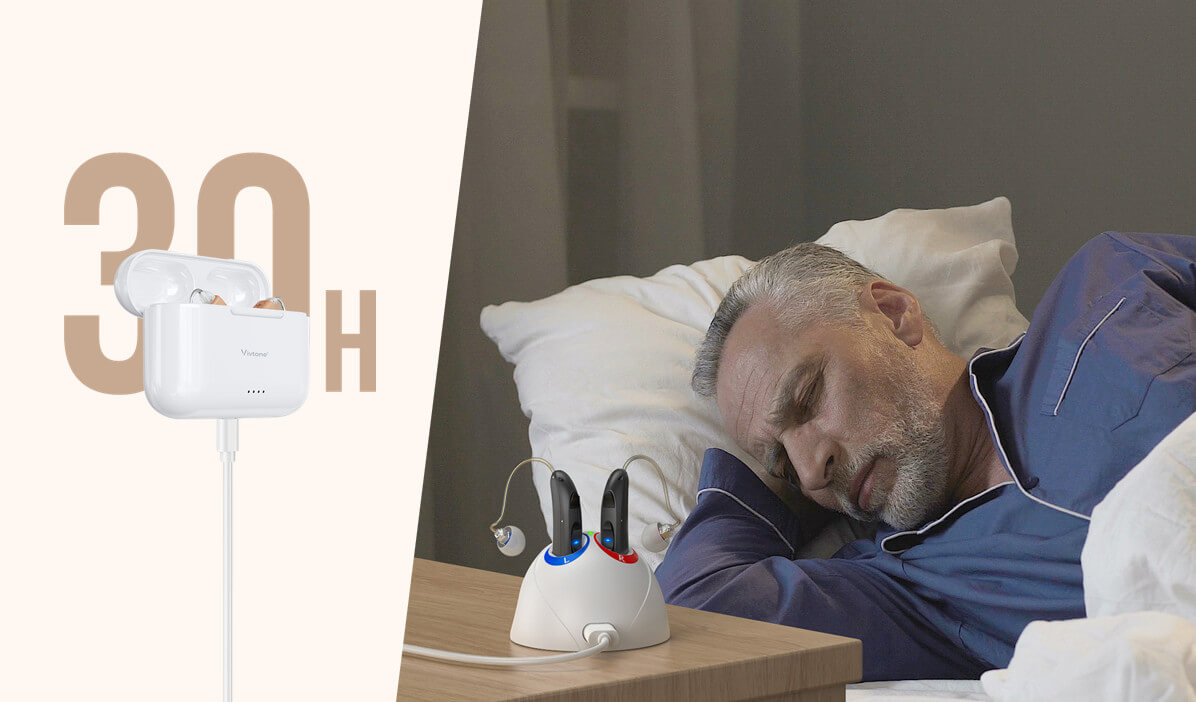
Free Shipping
Payment Security
45-Day Risk-Free Trial
24/7 Support Online
Get Voucher
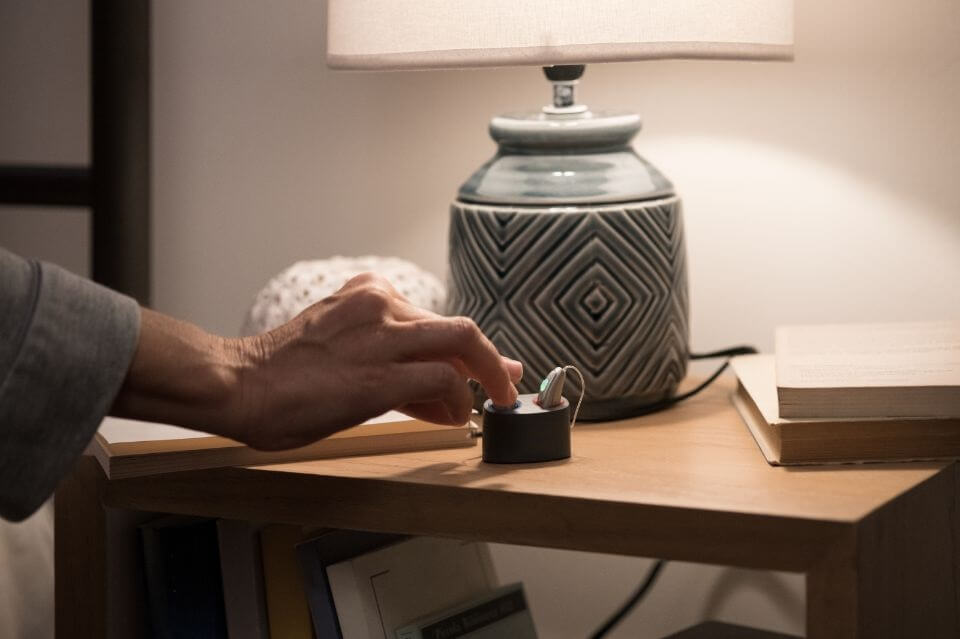
What are rechargeable hearing aids?
Rechargeable hearing aids are devices that eliminate the need for frequent battery replacements. They come with built-in rechargeable batteries. Users can charge them using a charging dock or cable. This feature offers convenience and cost savings over traditional disposable batteries.
Best Affordable Rechargeable Hearing Aids
The best affordable rechargeable hearing aids offer a balance of sound quality and the practicality of not needing to frequently replace batteries. They provide clear audio and are designed for user comfort, making them a cost-effective choice for managing hearing loss.

Do a free online hearing test now
100% free and takes less than 3 minutes
Get instant results from the comfort of home
Designed by audiologist, ENT doctors, hearing aid specialists, and sound engineers for maximum accuracy
TEST YOUR HEARINGHow long can rechargeable hearing aids be used on a single charge?
Vivtone rechargeable hearing aids offer varying battery lives, with the RIC02, Lucid30, XPURE, and Pro20 typically lasting 20 hours per charge, while the D09, Lucid516, and Lucid508 can go up to 30 hours on a single charge, depending on usage and settings.
They come with a warranty
Not only do in ear rechargeable hearing aids offer the convenience of not having to replace disposable batteries, but many also come with a warranty that covers the built-in battery for 1-2 years. And, for those concerned about battery lifespan, some manufacturers even offer battery replacement services for a fee. These options not only extend the lifespan of the hearing aid but also provide peace of mind for the user.
Different styles and sizes of rechargeable hearing aids
Rechargeable hearing aids come in a variety of styles and sizes to cater to individual needs and preferences.
Invisible and Rechargeable: CIC Hearing Aids
CIC hearing aids are favored for their discretion and efficacy. Designed to be fully concealed within the ear canal, these aids excel in delivering high-quality audio, particularly for higher-pitched sounds. Their snug fit and reduced wind noise make them a subtle yet powerful companion for diverse activities, improving sound directionality.
BEST CHOICE FROM VIVTONE
Vivtone Supermini CIC rechargeable hearing aids

- Completely-in-Canal (CIC) design
- Smart & Easy Operation
- Noise and background cancellation
- Fast charging: 30 hours working time, 150 hours backup power
- Perfect for Seniors, no more replacing batteries
10% discount
for new subscribers
Versatile and Rechargeable: BTE Hearing Aid
BTE hearing aids offer a powerful, adaptable solution for any hearing loss degree. Their larger size allows for ease of use and supports long-lasting rechargeable batteries. Designed for durability, they enable advanced capabilities to enrich your auditory experience.
BEST CHOICE FROM VIVTONE
Vivtone Lucid508 BTE rechargeable hearing aids

- 2 hours for a full charge, used for 25 hours. The charging case can charge both unites for 4 times, with 100 hours of backup power.
- Digital core for super natural and clear sound quality
- 3 professional modes with tinnitus masking
- Smaller size & light-weighted design
- Perfect for Seniors, no more replacing batteries
10% discount
for new subscribers
Personalized Listening with Bluetooth Rechargeable Hearing Aids
Bluetooth hearing aids link to your phone, enabling personalized settings through an app. They allow separate adjustments for each ear's volume and frequency, simplifying customization and avoiding complex manual adjustments on the device itself.
BEST CHOICE FROM VIVTONE
Vivtone XPURE bluetooth hearing aids

- Get hearing test on your phone, automatically configures hearing compensation according to your degree of hearing loss
- Dual directional microphones, multi-channel sound process
- Provide updating hearing experience to fit the change of your hearing loss, great for long term using.
- Rechargeable
10% discount
for new subscribers
Comfortable and Rechargeable: RIC Hearing Aids
RIC hearing aids balance coziness with acoustic clarity. The receiver, nestled in the earpiece, ensures a natural fit and supreme comfort. They're perfect for those seeking both ease and excellence in sound, delivering superior audio performance.
BEST CHOICE FROM VIVTONE
Vivtone Lucid516 RIC hearing aids

- Receiver-in-Canal (RIC) design to make the sound natural and clear
- 3 Hearing Modes for All Situation
- Fast & Recycle Charging:2 hours for a full charge, used for 30 hours
- Discreet Wearing & Smart On/Off
- Unlimited Customer Service
10% discount
for new subscribers
Discreet and Rechargeable: Smallest BTE Hearing Aid
Mini BTE hearing aids combine subtlety with comfort. Nestled behind the ear and connected by a slender tube or wire to the earpiece, these are the smallest of the BTE variety. They deliver sharp sound discreetly, ensuring your hearing aid remains virtually unseen.
BEST CHOICE FROM VIVTONE
Vivtone RIC02 invisible hearing aids

- Nearly invisible with a sleek design
- Advanced Hearing Aid with Receiver in Canal
- Dual Microphones & Adaptive Modes
- Secure Design & Water Resistant
- Perfect Gift for Seniors & Loved Ones
10% discount
for new subscribers
Powerful Rechargeable BTE Hearing Aids for an Active Lifestyle
Power BTE hearing aids are tailored for active individuals, featuring sizable batteries and potent amplifiers to thrive in demanding auditory settings. Modern versions boast a sleek look, blending style with functionality to provide an uncompromised listening experience.
BEST CHOICE FROM VIVTONE
Vivtone Lucid30 power hearing aids

- Powerful with two tube types: maximum sound gain of 53dB with thick tube
- 4 adaptive hearing modes for different indoor/outdoor environments
- Patented detachable batteries fully recharge in 2-3 hours. Included backup batteries
- US made components from well-known reputable brands
10% discount
for new subscribers
Optimize your hearing with exceptional ongoing support from a highly skilled team of licensed hearing professionals.

Sarah Palin, AuD
Head of Audiology
Dr. Sarah Palin is a licensed Audiologist based in Arizona. With expertise in hearing aid dispensing, counseling, education, and tinnitus management, she is dedicated to improving quality of life through better hearing.

Renate Ortlieb, AuD
Audiology
Dr. Renate Ortlieb is a licensed Audiologist in Illinois and Michigan, specialized in assessing and treating hearing disorders. With a Doctorate of Audiology (Au.D.) , she offers expert care and valuable insights into hearing aid technology.

Angela C.Bochetto, AuD
Audiology
Dr. Angela C. Bochetto is a licensed Audiologist in Texas with a Doctorate of Audiology (Au.D.) from Washington University School of Medicine. She specializes in comprehensive hearing evaluations, counseling, education, hearing aid dispensing, and treatment of hearing disorders.
FAQs

Get Voucher
Subscribe to get voucher 10% and more special offer
LEARN MORE ABOUT RECHARGEABLE HEARING AIDS
Rechargeable hearing aids are transforming the hearing care landscape with their sound amplification and clarity, especially in noisy settings. Their rechargeable batteries stand out, providing a hassle-free alternative to constant battery changes—just place them on a charging dock or connect them via USB to recharge. No more dealing with disposable batteries' cost and inconvenience.
These devices are not only user-friendly but also environmentally friendly, allowing for a full day's use after an overnight charge, eliminating worries about running out of power.
Available in BTE, RIC, and ITE styles, rechargeable hearing aids offer essential features like volume adjustment, noise cancellation, and directional microphones, now enhanced with the practicality of rechargeability.
Explore the benefits, understand the costs, learn maintenance strategies, and find answers to common queries about these essential tools that are improving the lives of people with hearing loss.
The technology behind rechargeable hearing aids
Rechargeable hearing aids harness cutting-edge Lithium-Ion (Li-ion) and Silver-Zinc (AgZn) battery technologies, blending efficiency with rapid charging capabilities. These batteries boast long life spans and quick recharge times, ensuring your hearing aid is always at the ready.
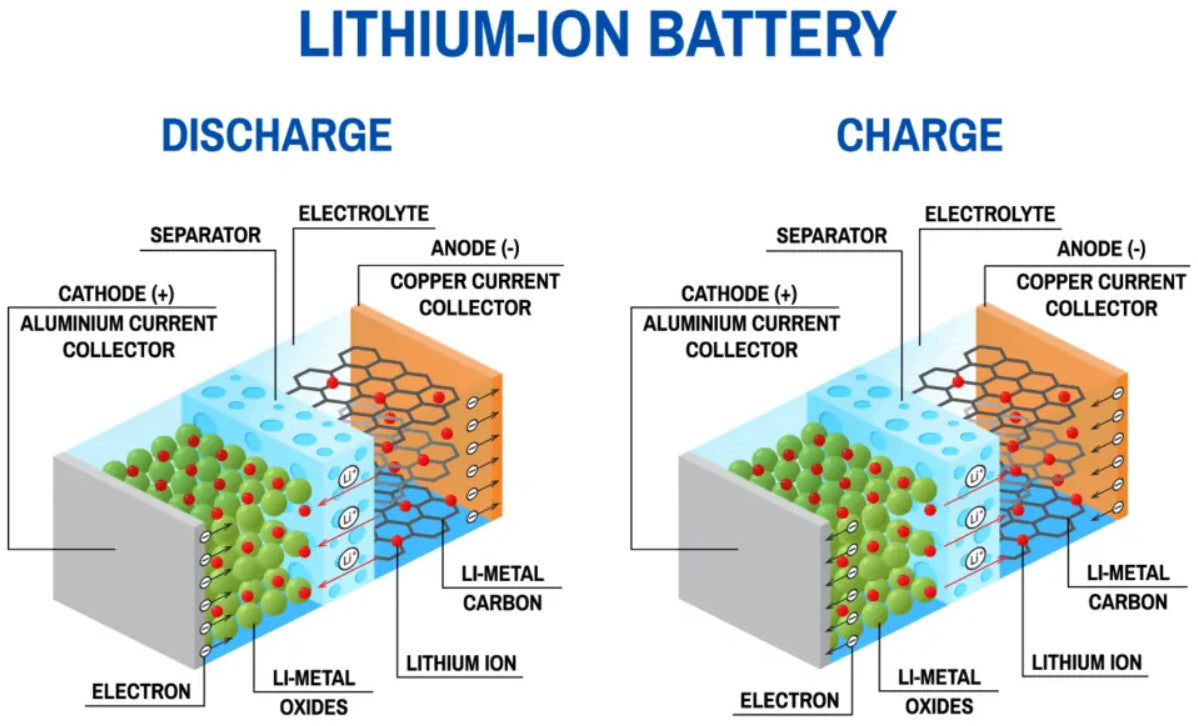
Li-ion Technology in Hearing Aids
Li-ion batteries, renowned for their high energy density, have revolutionized portable electronics, enabling slimmer hearing aid designs without compromising on power. They outlast traditional batteries, offering steady, reliable performance and contribute to sustainability by reducing the need for frequent replacements.
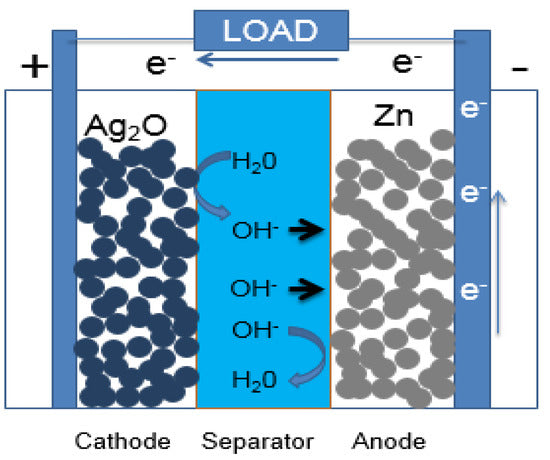
Silver-Zinc Technology in Hearing Aids
Silver-Zinc batteries, meanwhile, excel in energy storage capacity, supporting full-day use with eco-friendly advantages. They are non-toxic, completely recyclable, and position AgZn as a preferred choice for users looking for green options in hearing tech.
Both Li-ion and AgZn batteries stand at the forefront of rechargeable hearing aid innovation, providing efficient and dependable power that supports environmental consciousness. With these technologies, you can choose a hearing solution that aligns with your longevity needs and ecological preferences, promising consistent auditory support.
Structure of a rechargeable hearing aid
Rechargeable hearing aids are feats of miniaturized technology, expertly crafted to enhance auditory perception effortlessly. Central to their design is a high-capacity rechargeable battery that powers the device, doing away with the constant need for battery changes that traditional hearing aids demand.
Here's an overview of the components that make up a rechargeable hearing aid:
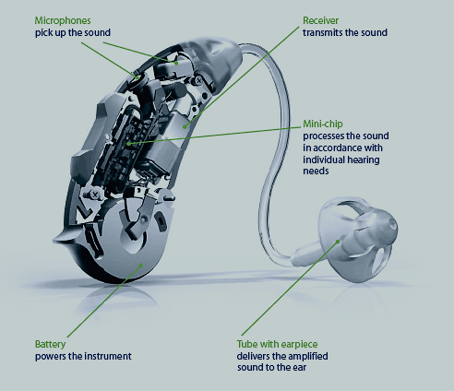
1. Microphone
The microphone serves as the starting point in the hearing aid's chain of operation. It picks up sounds from the environment and transforms them into digital signals. The sophistication of the microphone impacts the device's performance, affecting its ability to accurately capture both speech and background noises. Multi-microphone systems may be employed to help users discern the direction of sound, improving spatial awareness.
2. Digital Processor (Amplifier)
At the heart of the device is the digital processor, sometimes referred to as an amplifier or mini-chip. It amplifies the digital signals. This powerful processor filters out background noise, customizes volume, and tailors the sound to the user's hearing loss profile through advanced algorithms, ensuring that the output matches individual needs.
3. Receiver (Speaker)
The receiver, or speaker, then receives the enhanced digital signals from the processor and converts them back into audible sounds, channeled directly into the ear canal. Depending on the hearing aid style, the receiver can be placed close to the eardrum (as in RIC models) for optimal sound delivery.
4. Rechargeable Battery
Distinguishing itself from disposable options, the built-in rechargeable battery provides energy for an entire day's use after a single charge. These batteries have revolutionized hearing aids by enabling hundreds of recharges over their lifespan, vastly reducing the economic and environmental costs associated with battery replacement.
5. Charging Mechanism
The charging case or dock completes the rechargeable hearing aid experience. It's a streamlined and effective method of powering up the aids, often equipped with rapid charge capabilities, visual indicators for battery life, and an automatic cutoff to prevent overcharging. This system not only simplifies daily hearing aid upkeep but also promotes environmentally responsible habits by reducing waste.
In essence, rechargeable hearing aids merge meticulous electronic engineering with user-focused design to provide an advanced, manageable, and eco-friendly hearing support option. They exemplify the harmonious fusion of technical componentry and user interaction, revolutionizing the way people with hearing loss connect with their environment.
What are the benefits and advantages of rechargeable hearing aids?

We’ve done the heavy lifting for you to summarize the benefits and disadvantages of rechargeable hearing aids that you can find below:
1. Quick and easy to charge
Never miss a beat with rechargeable hearing aids that offer the convenience of overnight charging and quick-charging options, ensuring that you never have to go without your hearing aids for long. Simply plug in your device for a few hours of use or charge overnight for a full day of hearing.
2. Full-day use
Once fully charged, rechargeable hearing aids can typically provide a full day or more of use, eliminating the need for frequent battery changes.
3. More environmentally friendly
Not only do rechargeable hearing aids offer convenience and long-lasting power, they also have a positive impact on the environment. By using rechargeable batteries instead of disposable ones, they help reduce electronic waste and promote sustainable practices.
4. Easier to handle and safer
Rechargeable hearing aids are not only more convenient, but also safer to use compared to traditional hearing aids with small, disposable batteries that can be difficult to handle. With a built-in rechargeable battery, there's no need to fiddle with tiny battery compartments, reducing the risk of injury and frustration.
Drawbacks of rechargeable hearing aids

As practical and convenient as they are, rechargeable hearing aids do come with their own set of drawbacks:
1. Dependency on a charger
Rechargeable hearing aids require a charger to be functional, which can be a disadvantage for users who don't have access to a charger or who forget to charge their devices regularly.
2. Higher unit cost
While rechargeable hearing aids have many benefits, they can have a higher upfront cost compared to traditional hearing aids that use disposable batteries. This is because rechargeable hearing aids require more advanced battery technology and may come with additional features such as wireless connectivity. However, it's important to consider the long-term cost savings of not having to purchase disposable batteries regularly. Additionally, some insurance plans may cover the cost of rechargeable hearing aids or offer reimbursement options.
3. Fewer styles to choose from
While rechargeable hearing aids have many benefits, they may not be suitable for everyone. For example, individuals who live in areas with limited access to electricity or who have difficulty remembering to charge their devices regularly may find disposable battery-powered hearing aids more practical.
What do rechargeable hearing aids cost?

Rechargeable hearing aids can be more expensive upfront than traditional hearing aids that use disposable batteries, but they offer several advantages that may be worth the additional cost. Additionally, some users may find that the increased cost of rechargeable hearing aids is offset by the longer lifespan of the rechargeable battery and the potential savings from not having to purchase disposable batteries over time.
How much does a rechargeable hearing aid cost? The price can vary greatly, ranging from a few hundred dollars to several thousand dollars per device. Several factors affect the cost of rechargeable hearing aids, such as the level of technology, features, and the brand. Ultimately, the price will depend on your unique needs and budget:
1. Brand
Reputable brands may charge more for their rechargeable hearing aids due to factors such as research and development, marketing, and reputation. While you can have confidence in the quality of the device, lesser-known brands may offer similar features at a lower price. It's up to you to decide what matters most.
2. Features
Did you know that rechargeable bluetooth hearing aids and features like noise reduction, and speech enhancement can cost more than basic models? It's true! If you're looking for top-of-the-line features, be prepared to pay a premium. But, if you're content with a more straightforward option, basic models can still do the job at a lower cost. The choice is yours!
3. Style
If you're in the market for a rechargeable hearing aid, you'll be pleased to know that there are a variety of styles to choose from! You can opt for a behind-the-ear (BTE), in-the-ear (ITE), or completely-in-canal (CIC) option depending on your needs and preferences. But, here's something to keep in mind: smaller and more discreet styles can be more expensive than larger and more visible ones. So, if you're willing to show off your device, you may be able to save a few dollars without sacrificing quality. On the other hand, if you value discretion, you may want to splurge on a smaller option.
4. Warranty
Did you know that the length of a rechargeable hearing aid's warranty can affect its price? It's true! Devices with longer warranties may cost more than those with shorter warranties. But, here's the upside: a longer warranty can give you peace of mind knowing that you're covered in case anything goes wrong. However, if you're on a tight budget, a device with a shorter warranty may still be a good option, especially if you take good care of it. It all depends on what you're comfortable with!
FAQs
How long do rechargeable hearing aid batteries last?

The lifespan of rechargeable hearing aid batteries can vary depending on the type of battery technology used and the brand or model of the hearing aid. On average, you can expect the following:
1. Daily Usage Time:Rechargeable hearing aid batteries generally provide enough power to last through a full day on a single charge. This typically means anywhere from 12 to 30 hours of use, though this can be influenced by factors such as the volume at which the hearing aid is set, streaming usage, and the complexity of sounds it needs to process.
2. Longevity of the Battery Itself:
Most rechargeable hearing aid batteries will last for several years before they need replacing. The two most common types of rechargeable batteries used in hearing aids are Lithium-Ion (Li-ion) and Silver-Zinc (AgZn).
● Lithium-Ion (Li-ion): These batteries are currently the most popular choice for rechargeable hearing aids. They usually have a lifespan of about 3 to 5 years, after which they may need to be replaced by the manufacturer, as they're often integrated into the hearing aid's design.
● Silver-Zinc (AgZn): Although not as widely used as Li-ion, Silver-Zinc batteries can also last several years, and the advantage of these batteries is that they are often user-replaceable.
It's important to note that just like any other battery, the capacity of rechargeable hearing aid batteries can diminish over time. This means that while the battery may last for several years, the amount of time you get on a single charge may decrease gradually.
How to store rechargeable hearing aids?
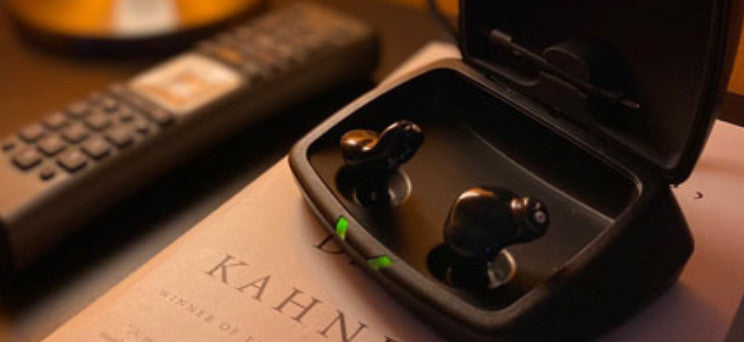
Proper storage of rechargeable hearing aids can help extend their lifespan and ensure they remain in good working condition. Here are some tips for storing rechargeable hearing aids:
1. Charge when not in use
Keep your rechargeable hearing aids charged by placing them in the charger when not in use. This helps ensure that they're always ready to go when you need them and prevents battery drain over time.
2. Turn them off every now and then
If you are not going to use the hearing aids for a while, turn them off and put them in a safe place: This will help conserve battery life and prevent any damage to the devices. Make sure to store them in a cool, dry place away from direct sunlight and moisture.
3. Clean them
Clean your rechargeable hearing aids before storing them to prevent buildup that can affect their performance. Use a clean, dry cloth to remove earwax and debris.
4. Keep the hearing aids and charger away from magnets
Magnets can interfere with the charging and operation of rechargeable hearing aids. Avoid placing them near any magnetic objects or devices.
How to clean and maintain rechargeable hearing aids?
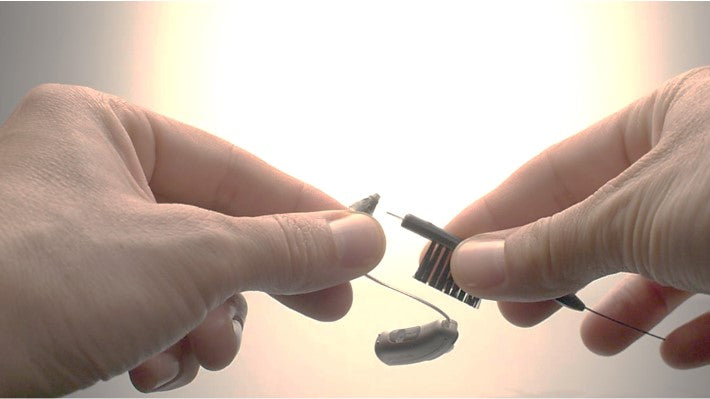
Proper cleaning and maintenance of rechargeable hearing aids can help ensure they continue to function properly and last longer. Here are some tips on how to clean and maintain rechargeable hearing aids:
1. Use a brush to clean the hearing aids and charger contact
Want to keep your rechargeable hearing aids and charger in top condition? Then grab a soft-bristled brush and get ready to clean! By using a brush to remove any earwax, debris, or dust that may have accumulated on the devices and charging contact, you can help prevent any buildup that could impact their performance. And with regular cleaning, you'll be able to enjoy clear, reliable sound quality every day.
2. Replace the wax filters or tubes every 2-3 weeks
Wax filters and tubes can become clogged over time in your rechargeable hearing aids BTE, which can affect the quality of sound produced by the hearing aids. It's important to replace them every 2-3 weeks or as recommended by the manufacturer.
3. Use a soft cloth to wipe down the outside of the hearing aid
It is highly advisable to preserve the cleanliness and optimal functionality of your hearing aid by employing a clean, dry, and soft cloth to delicately wipe the external surface of the device. This practice effectively removes any accumulation of dirt, dust, or other debris that may compromise the efficacy of the device. By consistently adhering to this straightforward maintenance routine, one can guarantee that their hearing aid will continue to function properly and provide exceptional sound quality for an extended period of time.
4. Keep the hearing aids away from moisture whenever possible
Moisture can damage the hearing aids, so it's important to keep them away from water or any other source of moisture. This includes removing them before showering or swimming, and storing them in a dry, cool place.
5. Follow the manufacturer's instructions for cleaning and maintenance
It is imperative to follow the cleaning and maintenance procedures recommended by the manufacturer for different types of rechargeable hearing aids. Such instructions may be found in the user manual or on the manufacturer's website, and failure to comply may lead to inadequate device performance or damage to the equipment.
Conclusion
Rechargeable hearing aids offer a trifecta of benefits: convenience, cost-effectiveness, and environmental sustainability. Users can recharge their devices overnight and enjoy a full day of use without worrying about frequent battery replacements.
Not only is this more convenient, but it's also eco-friendly as rechargeable batteries produce less waste compared to disposable batteries. In short, rechargeable hearing aids are a smart choice for both your hearing health and the planet.
Therefore, if you are looking for a hearing aid, it's worth considering rechargeable hearing aids as a hassle-free option that will serve you for years on end. With rechargeable hearing aids, you can enjoy the benefits of clear and reliable sound without the hassle and expense of frequent battery replacements.
There are many affordable options available on the market, and Vivtone Hearing Aids is a great place to start exploring to find the best rechargeable hearing aids for your needs. Want to secure yourself a mighty fine deal? Then we encourage you to give our catalog a look!
Vivtone Rechargeable Hearing Aids Collection
FAQs
Have questions? Call us now (833) 938-1277
( MON-FRI 9AM-5PM EST, 24/7 VIA EMAIL: SUPPORT@VIVTONE.COM )
WE ARE HERE FOR YOU




